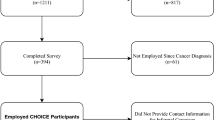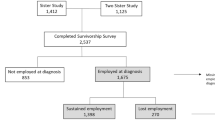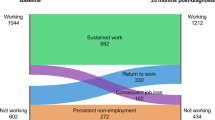Abstract
Introduction
Risk factors for employment difficulties after cancer diagnosis are incompletely understood, and interventions to improve post-cancer employment remain few. New targets for intervention are needed.
Methods
We assessed a cohort of 530 nonmetastatic cancer patients (aged ≤ 65 years, >6 months from diagnosis, off chemo- or radiotherapy) from the observational multi-site Symptom Outcomes and Practice Patterns study. Participants reported employment change, current employment, and symptoms. Groups were based on employment at survey (working full- or part-time versus not working) and whether there had been a change due to illness (yes versus no). The predictive power of symptom interference with work was evaluated for employment group (working stably versus no longer working). Race/ethnicity, gender, cancer type, therapy, and time since diagnosis were also assessed. Association between employment group and specific symptoms was examined.
Results
The cohort was largely non-Hispanic white (76 %), female (85 %), and diagnosed with breast cancer (75 %); 24 % reported a change in employment. On multivariable analysis, participants with at least moderate symptom interference were more likely to report no longer working than their less effected counterparts (odds ratio (OR) = 8.0, 95 % CI, 4.2–15.4), as were minority participants compared with their non-Hispanic white counterparts (OR = 3.2, 95 % CI, 1.8–5.6). Results from the multiple regression model indicated the combination of fatigue (OR = 2.3, 95 % CI, 1.1–4.7), distress (OR = 3.9, 95 % CI, 1.7–9.0), and dry mouth (OR = 2.6, 95 % CI, 1.1–6.2) together with race/ethnicity and time since diagnosis adequately accounted for employment group.
Conclusions
Our findings support the hypothesis that residual symptom burden is related to post-cancer employment: Residual symptoms may be targets for intervention to improve work outcomes among cancer survivors.
Implications for Cancer Survivors
This analysis examines whether increased symptom burden is associated with a change to not working following a cancer diagnosis. We also examined individual symptoms to assess which symptoms were most strongly associated with not working after a cancer diagnosis. Our hope is that we will be able to use this information to both screen survivors post-active treatment as well as target high-risk symptoms for further and more aggressive intervention, in an attempt to improve post-cancer work outcomes.

Similar content being viewed by others
References
Siegel R, Naishadham D, Jemal A. Cancer statistics. CA Cancer J Clin. 2012;62(1):10–29.
Parry C, et al. Cancer survivors: a booming population. Cancer Epidemiol Biomark Prev. 2011;20(10):1996–2005.
de Boer AG, et al. Cancer survivors and unemployment: a meta-analysis and meta-regression. JAMA. 2009;301(7):753–62.
Mehnert A. Employment and work-related issues in cancer survivors. Crit Rev Oncol Hematol. 2011;77(2):109–30.
Taskila T, et al. Comparative study of work ability between cancer survivors and their referents. Eur J Cancer. 2007;43(5):914–20.
Hansen JA, et al. Breast cancer survivors at work. J Occup Envrion Med. 2008;50(7):777–84.
Hewitt M, et al. From Cancer Patient to Cancer Survivor: Lost in Translation. Institute of Medicine. Washington, DC: The National Academies Press; 2005.
Hassett MJ, O’Malley AJ, Keating NL. Factors influencing changes in employment among women with newly diagnosed breast cancer. Cancer. 2009;115(12):2775–82.
Bouknight RR, Bradley CJ, Luo Z. Correlates of return to work for breast cancer survivors. J Clin Oncol. 2006;24(3):345–53.
Johnsson A, et al. Predictors of return to work ten months after primary breast cancer surgery. Acta Oncol. 2009;48(1):93–8.
Johnsson A, et al. Work status and life changes in the first year after breast cancer diagnosis. Work. 2011;38(4):337–46.
Feuerstein M, et al. Work in cancer survivors: a model for practice and research. J Cancer Survivorship: Res Pract. 2010;4(4):415–37.
Thijs KM, et al. Rehabilitation using high-intensity physical training and long-term return-to-work in cancer survivors. J Occup Rehabil. 2012;22(2):220–9.
Strauser D, et al. Vocational services associated with competitive employment in 18–25 year old cancer survivors. J Cancer Survivorship: Res Pract. 2010;4(2):179–86.
Shi Q, et al. Symptom burden in cancer survivors 1 year after diagnosis: a report from the American Cancer Society’s studies of cancer survivors. Cancer. 2011;117(12):2779–90.
Harrington CB, et al. It’s not over when it’s over: long-term symptoms in cancer survivors–a systematic review. Int J Psychiatry Med. 2010;40(2):163–81.
Heidrich SM, et al. An individualized representational intervention to improve symptom management (IRIS) in older breast cancer survivors: three pilot studies. Oncol Nurs Forum. 2009;36(3):E133–43.
Bradley CJ, et al. Employment and cancer: findings from a longitudinal study of breast and prostate cancer survivors. Cancer Invest. 2007;25(1):47–54.
Bradley CJ, Bednarek HL. Employment patterns of long-term cancer survivors. Psychooncology. 2002;11(3):188–98.
Bradley CJ, et al. Employment outcomes of men treated for prostate cancer. J Natl Cancer Inst. 2005;97(13):958–65.
Spelten ER, et al. Cancer, fatigue and the return of patients to work-a prospective cohort study. Eur J Cancer. 2003;39(11):1562–7.
Carlsen K, et al. Risk for unemployment of cancer survivors: a Danish cohort study. Eur J Cancer. 2008;44(13):1866–74.
Sanchez KM, Richardson JL, Mason HR. The return to work experiences of colorectal cancer survivors. AAOHN J. 2004;52(12):500–10.
Short PF, Vasey JJ, Tunceli K. Employment pathways in a large cohort of adult cancer survivors. Cancer. 2005;103(6):1292–301.
Tiedtke C, et al. Experiences and concerns about 'returning to work' for women breast cancer survivors: a literature review. Psychooncology. 2010;19(7):677–83.
Spelten ER, Sprangers MAG, Verbeek JHA. Factors reported to influence the return to work of cancer survivors: a literature review. Psycho-Oncology. 2002;11(2):124–31.
Maunsell E, et al. Work problems after breast cancer: an exploratory qualitative study. Psycho-Oncology. 1999;8(6):467–73.
Gaston-Johansson F, et al. Fatigue, pain, and depression in pre-autotransplant breast cancer patients. Cancer Pract. 1999;7(5):240–7.
Fox SW, Lyon D. Symptom clusters and quality of life in survivors of ovarian cancer. Cancer Nurs. 2007;30(5):354–61.
Dodd MJ, Miaskowski C, Lee KA. Occurrence of symptom clusters. J Natl Cancer Inst Monogr. 2004;32:76–8.
Given BA, et al. Symptom clusters and physical function for patients receiving chemotherapy. Semin Oncol Nurs. 2007;23(2):121–6.
Bower JE. Management of cancer-related fatigue. Clin Adv Hematol Oncol. 2006;4(11):828–9.
Bower JE. Prevalence and causes of fatigue after cancer treatment: the next generation of research. J Clin Oncol. 2005;23(33):8280–2.
Rietman JS, et al. Impairments, disabilities and health related quality of life after treatment for breast cancer: a follow-up study 2.7 years after surgery. Disabil Rehabil. 2004;26(2):78–84.
Fialka-Moser V, et al. Cancer rehabilitation: particularly with aspects on physical impairments. J Rehabil Med. 2003;35(4):153–62.
Gordon LG, et al. The impact of rehabilitation support services on health-related quality of life for women with breast cancer. Breast Cancer Res Treat. 2005;93(3):217–26.
Norman SA, et al. Lymphedema in breast cancer survivors: incidence, degree, time course, treatment, and symptoms. J Clin Oncol. 2009;27(3):390–7.
Munir F, et al. Women’s perceptions of chemotherapy-induced cognitive side effects on work ability: a focus group study, in J Clin Nurs. 2010: England. p. 1362–70.
Calvio L, et al. Measures of cognitive function and work in occupationally active breast cancer survivors. J Occup Environ Med. 2010;52(2):219–27.
Boykoff N, Moieni M, Subramanian SK. Confronting chemobrain: an in-depth look at survivors’ reports of impact on work, social networks, and health care response. J Cancer Surviv. 2009;3:223–32.
Oberst K, et al. Work task disability in employed breast and prostate cancer patients. J Cancer Surviv. 2010;4(4):322–30.
de Boer AG, et al. Work ability and return-to-work in cancer patients. Br J Cancer. 2008;98(8):1342–7.
Drolet M, et al. Work absence after breast cancer diagnosis: a population-based study. CMAJ. 2005;173(7):765–71.
Mols F, et al. Long-term cancer survivors experience work changes after diagnosis: results of a population-based study. Psychooncology, 2009.
Hansen JA, et al. Breast cancer survivors at work. J Occup Environ Med. 2008;50(7):777–84.
Cleeland CS, et al. Assessing symptom distress in cancer patients: the M.D. Anderson Symptom Inventory. Cancer. 2000;89(7):1634–46.
Fisch MJ, et al. Prospective, observational study of pain and analgesic prescribing in medical oncology outpatients with breast, colorectal, lung, or prostate cancer. J Clin Oncol. 2012;30(16):1980–8.
Tevaarwerk A, et al. Predictors of employment outcomes in breast cancer (BrCa) patients: an analysis from E2Z02 (ECOG’s SOAPP study). in San Antonio Breast Cancer Symposium (abstract). 2010.
Palos GR, et al. Asking the community about cutpoints used to describe mild, moderate, and severe pain. J Pain: J Am Pain Soc. 2006;7(1):49–56.
Serlin RC, et al. When is cancer pain mild, moderate or severe? Grading pain severity by its interference with function. Pain. 1995;61(2):277–84.
Jeon S, et al. Do interference-based cut-points differentiate mild, moderate, and severe levels of 16 cancer-related symptoms over time? J Pain Symptom Manag. 2009;37(2):220–32.
Selby D, et al. A single set of numerical cutpoints to define moderate and severe symptoms for the Edmonton Symptom Assessment System. J Pain Symptom Manag. 2010;39(2):241–9.
Zeger SL, Liang KY. Longitudinal data analysis for discrete and continuous outcomes. Biometrics. 1986;42(1):121–30.
Hardin J, Hilbe J, editors. Generalized estimating equations. Boca Raton: Chapman & Hall/CRC; 2003.
Cancer Survivor Registry. The Breast Cancer M.A.P. Project. 2011. Accessed at https://csc.breastcancerregistry.org/.
Johnsson A, et al. Factors associated with return to work after breast cancer treatment. Acta Oncologica. 2007;46(1):90–6.
Ramsey S, et al. Cancer diagnosis as a risk factor for personal bankruptcy. 2011. J Clin Oncol 29:385s (suppl; abstr 6007).
Ahn E, et al. Impact of breast cancer diagnosis and treatment on work-related life and factors affecting them. Breast Cancer Res Treat. 2009;116(3):609–16.
Verbeek J, et al. Return to work of cancer survivors: a prospective cohort study into the quality of rehabilitation by occupational physicians. Occup Environ Med. 2003;60(5):352–7.
Yancik R, et al. Effect of age and comorbidity in postmenopausal breast cancer patients aged 55 years and older. JAMA. 2001;285(7):885–92.
de Boer AGEM, Frings-Dresen MHW. Employment and the common cancers: return to work of cancer survivors. Occup Med. 2009;59(6):378–80.
Bradley CJ, et al. Short-term effects of breast cancer on labor market attachment: results from a longitudinal study. J Health Econ. 2005;24(1):137–60.
Hansen A, Edlund C, Henningsson M. Factors relevant to a return to work: a multivariate approach. Work. 2006;26(2):179–90.
Purdie F, Kellett S, Bickerstaffe D. Predictors of Functional Disability in Disability Welfare Claimants. J Occup Rehab, 2012 (Epub).
Stewart CM, et al. Salivary dysfunction and quality of life in Sjogren syndrome: a critical oral-systemic connection. J Am Dent Assoc. 008;139(3):291–9. quiz 358–9.
Molassiotis A, Rogers M. Symptom experience and regaining normality in the first year following a diagnosis of head and neck cancer: A qualitative longitudinal study. Palliative Supportive Care, 2012;1–8.
Perez EA. Safety of aromatase inhibitors in the adjuvant setting. Breast Cancer Res Treat. 2007;105 Suppl 1:75–89.
Chambers MS, et al. Radiation-induced xerostomia in patients with head and neck cancer: pathogenesis, impact on quality of life, and management. Head Neck. 2004;26(9):796–807.
Rowland J, et al. Cancer survivorship—United States, 1971–2001. MMWR. 2004;53:526–9.
de Boer AGEM, et al. Interventions to enhance return-to-work for cancer patients. Cochrane Database Syst Rev. 2011 Feb 16;(2):CD007569
Acknowledgments
The authors would like to thank the patients, research staff, and physicians who participated in the SOAPP study.
Disclosures
All authors report no financial disclosures. Dr. Tevaarwerk is supported by an Institute of Clinical and Translational Research KL2 Scholar grant, 9U54TR00021.
Funding source
This study was conducted by the Eastern Cooperative Oncology Group (Robert L. Comis, M.D.) and supported in part by Public Health Service Grants CA3403, CA21076, CA17145, and CA15488, and from the National Cancer Institute, National Institutes of Health, and the Department of Health and Human Services. Its contents are solely the responsibility of the authors and do not necessarily represent the official views of the National Cancer Institute.
Author information
Authors and Affiliations
Corresponding author
Rights and permissions
About this article
Cite this article
Tevaarwerk, A.J., Lee, J.W., Sesto, M.E. et al. Employment outcomes among survivors of common cancers: the Symptom Outcomes and Practice Patterns (SOAPP) study. J Cancer Surviv 7, 191–202 (2013). https://doi.org/10.1007/s11764-012-0258-2
Received:
Accepted:
Published:
Issue Date:
DOI: https://doi.org/10.1007/s11764-012-0258-2




